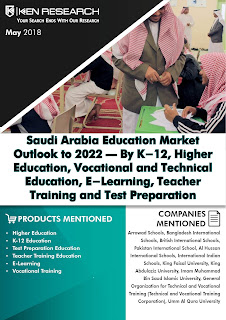Saudi Arabia Education Market by Sectors (Higher Education, K-12 Education, Vocational and Technical Training, E-Learning, Vocational Training and Test Preparation Education), Saudi Arabia K-12 Education Industry by Level of Education (Primary, Intermediary and Secondary), by International and Domestic / Local Schools, by Type of Schools (Government and Private), Saudi Arabia Higher Education Industry by Type of Universities (Government, Private, Others), by Gender (Male and Female), Segmentation by Academic Degree (Bachelor’s, Average Diploma and Postgraduate), Segmentation by Field of Study (Business Management, Humanities, Islamic Studies, Main Programs, Health, Social and Behavioral Sciences, Informatics, Engineering and Others), by Region (Makkah, Riyadh, Eastern Province, Medina, Asir, Qassim, Jazan, Tabuk, Hail, Al Jouf, Al Baha, Northern Border Area and Najran), Saudi Arabia Teacher Training Industry by Nationality (Saudi and Non-Saudi), by Type of Institutes (Training Institutes, Technical Colleges), Saudi Arabia E-Learning Industry by End Users (Higher Education, K-12 Schools, Corporate Sector and Others), by Type of Services (Content Services and Technology Services), Saudi Arabia Test Preparation Industry by Types of Tests (TOEFL, IELTS, GMAT, GRE and SAT), Company Profile of Major schools in K-12 (Arrowad Schools, Bangladesh International Schools, British International Schools, Pakistan International School, Al Hussan International Schools, International Indian Schools, My Little School International, American International School Riyadh, British International School Riyadh, Advanced Learning Schools, Al-Faris International School, Al Hussan International School Riyadh, Manarat Al Riyadh-International Section, King Faisal School, Al Forsan International School, Al Yasmin International School and Rowad Al Khaleej International School Riyadh), Higher Education University (King Faisal University, King Abdulaziz University, Imam Muhammad Bin Saud Islamic University, General Organization for Technical and Vocational Training (Technical and Vocational Training Corporation) and Umm Al Qura University), Vocational and Technical Training Player (Technical and Vocational Training Corporation), E-Learning and Test Prep Centers (Alwasaet, New Horizons, Edraak, Integrated Solutions for Business (ISB), Board Middle East (BME), Nafham, Harf Information Technology, Smartway, Rwaq.org, Edutacs, edX, Score Plus, English Gate Academy, Inlingua, Capstone Learning, KASCO, AMIDEAST and British Council)
Ken Research in its latest study, Saudi Arabia Education Industry Outlook to 2022 - by Higher Education, K-12 Education, E-Learning, Vocational Training, Teacher Training Market and Test-Preparation Education believe that focus on collaborating with government educational institutions, emphasis on bilingual courses and offering vocational services, which can assist the people in getting employed will aid the education market. Developing E-Learning Portals to meet the growing demand will have positive impact on market. Saudi Arabia Education market is expected to register positive CAGR of around 8.6% during the period 2017-2022.
- The continuous rise in the school fee is estimated to be amongst the major reasons which are anticipated to drive the overall education industry in a positive manner.
- Enhanced enrollments to all government, private and other higher education colleges which offer specialized courses are expected to drive the industry revenues.
- The 2030 vision of the government for thriving economy is expected to support the development of universities and colleges.
Significant budget allocation to education sector of the country in 2017 is expected to assist in the development of education industry, thus leading to the growth of all education sectors in Saudi Arabia. Private players entering the space with more numbers of tie-ups between the government universities and global players are further anticipated to boost the industry revenues due to increased enrollments to colleges in Saudi Arabia. Increasing number of organizations offering scholarships to students who wish to study abroad are projected to fuel the enrollments and revenues of the test preparation education sector, thus having a positive impact on the overall industry revenues. The increased demand for higher education in the Kingdom is anticipated to boost the fee over the long term, thus making people pay more for higher education services in the country. The increased expenditure of the people is expected to surge the revenues of various colleges and universities operating in the space.
The industry is also expected to drive positively due to increasing adoption of learning management systems by the growing corporate and education sector. The increasing use of modern technology as a part of e-learning sector is projected to benefit the education industry during the long term. The education industry in the Kingdom is estimated to witness surging revenues due to the 2030 vision of thriving economy which focuses on educating more people for the development of the nation during the long term. Continuous emphasis of the government and private authorities to enhance vocational skills in Saudi nationals is anticipated to expand the training and technical institutions, thereby resulting in a positive growth of the industry.
For more information on the research report, refer to below link:
Related Reports by Ken Research:
The UAE education market will grow at a considerable CAGR rate thus exceeding USD 6.7 billion by 2018 due to the increasing number of students and increase in tuition fees
https://www.kenresearch.com/education-and-recruitment/education/india-education-industry/272-99.html
The education market in India is one of the largest education systems globally which has registered a robust growth rate over the period.
The report provides a comprehensive analysis on various aspects such as market size of pre-primary, primary, secondary and higher education sector on the basis of learners, educators.
Contact Us:
Ken Research
Ankur Gupta, Head Marketing & Communications
Sales@kenresearch.com
+91-124 423 0204
Ken Research
Ankur Gupta, Head Marketing & Communications
Sales@kenresearch.com
+91-124 423 0204







